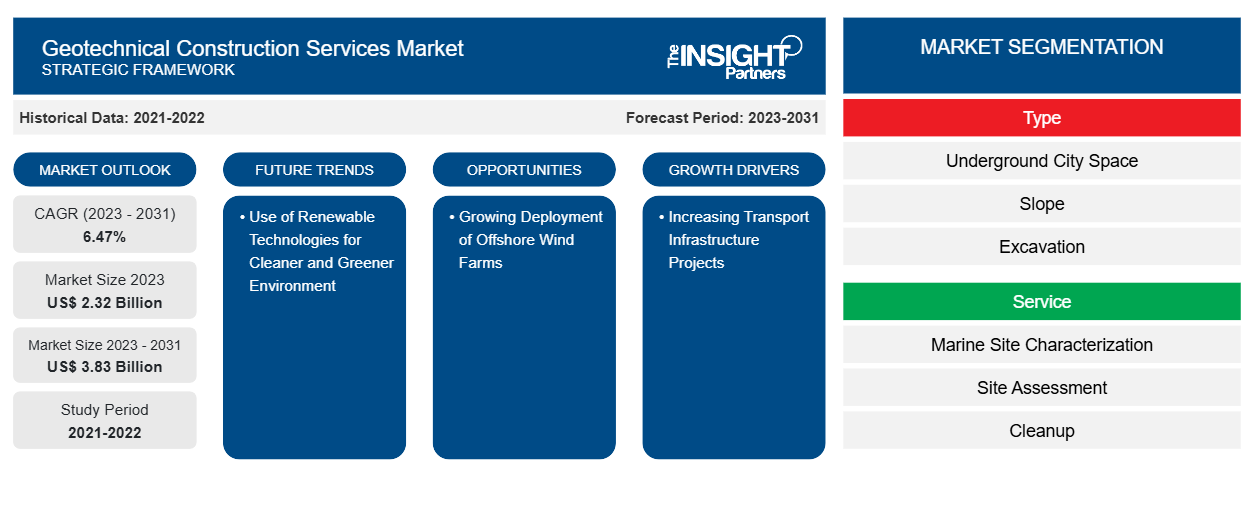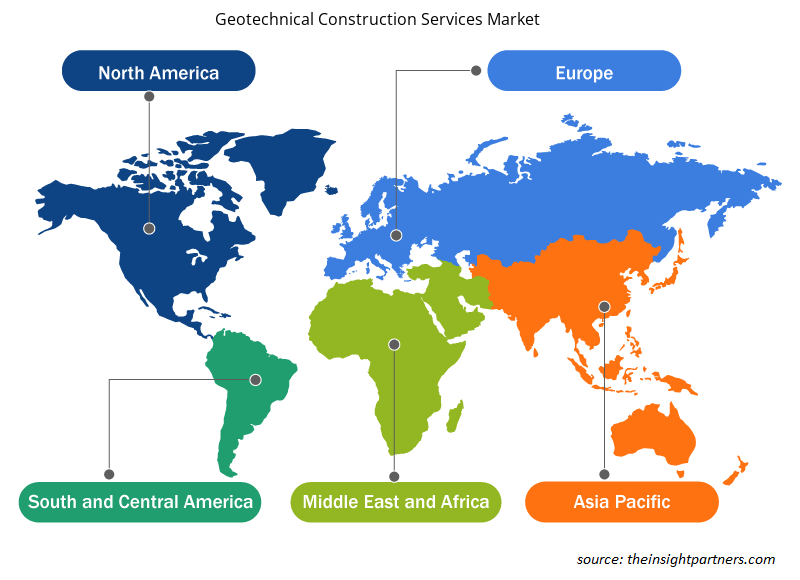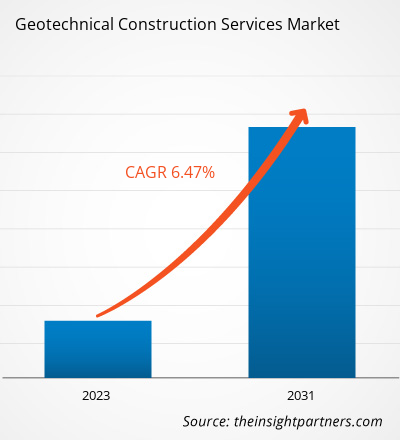지반 건설 서비스 시장은 2024년에 26억 7천만 달러 규모로 평가되었으며, 2031년까지 38억 3천만 달러에 이를 것으로 예상됩니다. 2025년부터 2031년까지 연평균 성장률 6.2%를 기록할 것으로 예상됩니다.
지반 공학 서비스는 건설 분야뿐만 아니라 석유 및 가스 산업과 광업 분야에서도 활용됩니다. 지반 공학 서비스 시장은 신흥 경제권의 건설 사업에 정부 기관이 막대한 자금을 투자하는 데 힘입어 성장하고 있습니다. 또한, 향후 석유 및 가스 프로젝트의 발전은 지반 계측 및 모니터링 산업에도 긍정적인 영향을 미칠 것으로 예상됩니다.
지반 건설 서비스 시장 분석
지반 건설 서비스 시장 생태계는 건설 회사, 지반 건설 서비스 전문가, 지반 건설 장비 제조업체 및 관련 애플리케이션 등 다양한 이해관계자로 구성됩니다. 건설 회사는 시공을 시작하기 전에 다양한 지반 건설 서비스 제공업체와 접촉합니다. 얕은 기초 및 깊은 기초, 댐 및 테일링 댐 설계, 제방 및 굴착 안정성 분석, 지반 개량 설계, 지반 앵커 및 소일네일 설계, 홍수 방지 구조물, 그라우트 커튼 설계, 포장도로, 폐기물 저장 및 석호, 터널 설계, 지하 구조물 설계 등은 전문가가 건설 회사에 제공하는 서비스의 일부입니다. Arup, EGS, Fugro, Geosyntec Consultants, Inc. 등은 건설 활동에 대한 컨설팅 서비스를 제공하는 몇몇 회사입니다. 지반 건설 전문가는 시험 목적으로 Proctor 다짐 및 밀도 장비, 범용 시료 추출기, 접지 저항 시험기, 전자 디지털 계량기 등 다양한 장비를 사용합니다. 앞서 언급한 지반 공학 건설 서비스는 철도, 공항, 터널, 상업 및 주택 건물 , 플랜트, 공장 등 다양한 용도로 사용됩니다 .
지반 건설 서비스 시장 개요
광물은 다양한 용도로 사용되어 인류 문명의 발전을 촉진해 왔기 때문에 인류 문명의 근간을 이룹니다. 광물과 광물 제품은 발전, 제조, 화학 및 석유화학, 의료 및 제약, 건설 등 다양한 산업 분야에서 사용됩니다. 광산 부지를 조성하려면 지표 및 지하 매핑, 지하 지지 분석, 채굴장, 갱도, 경사, 표류 및 터널 설계, 지반 침하 연구, 갱도 및 표류 조사 및 설계, 지질 노두 매핑, 지표 지구물리 조사, 정수, 산업 및 광미 처리 댐 설계 등을 위한 지반 공학 및 토공 설계 전문 지식이 필요합니다. 현재 석탄, 금, 철광석, 알루미늄, 구리는 산업 분야에서 광범위하게 사용되어 가장 많이 채굴되는 광물입니다. 이러한 광물 수요 증가는 광업의 확산을 뒷받침하여 지반 공학 건설 서비스 시장 성장을 촉진하고 있습니다.
이 보고서의 일부 또는 국가 수준 분석, Excel 데이터 팩을 포함하여 모든 보고서에 대한 사용자 정의를 무료로 받을 수 있으며, 신생 기업 및 대학을 위한 훌륭한 혜택과 할인도 이용할 수 있습니다.
지반 건설 서비스 시장: 전략적 통찰력

-
이 보고서에서 주요 시장 동향을 알아보세요.이 무료 샘플에는 시장 동향부터 추정치 및 예측까지 다양한 데이터 분석이 포함됩니다.
지반 건설 서비스 시장 동인 및 기회
교통 인프라 프로젝트 확대
교통 인프라는 모든 경제 발전에 중요한 역할을 합니다. 상품의 효율적인 생산 및 유통, 관광 및 접객 산업의 번영에 필수적입니다. 도로, 항만, 공항, 철도는 지반 공학적 시공 전문성을 요구하는 복잡한 엔지니어링 프로젝트입니다. 경제 개발에 대한 관심이 높아짐에 따라 여러 선진국과 개발도상국의 정부는 교통 인프라 개발에 상당한 투자를 하고 있습니다. 예를 들어, 중국 정부는 2035년까지 215개의 공항을 추가로 건설할 계획입니다. 2021년 3월, 중국 정부는 청두와 린즈를 연결하는 1,011km 길이의 철도 노선 건설 계획을 발표했으며, 이 사업에는 약 480억 달러가 투자되었습니다. 2020년에는 독일과 덴마크를 잇는 세계 최장의 침매 철도 및 도로 터널 프로젝트가 승인되었습니다. 이 터널은 Femern A/S가 시공할 예정입니다. 2020년 9월에는 체네리 베이스 철도 터널이 완공되었습니다. 이 철도 터널은 향후 지중해와 북해를 연결할 것으로 예상됩니다. 2018년 6월, 스웨덴 정부는 총 예산 약 760억 달러(미화)를 포함한 2018-2029년 국가 교통 계획을 수립하기 시작했습니다. 이 계획은 기존 철도망의 현대화 및 업그레이드와 더불어 여러 신규 철도 건설에 중점을 둘 것입니다. 2020년 11월, 영국 정부는 22억 달러(미화) 규모의 스톤헨지 로드 터널 프로젝트를 승인했습니다. 2019년 6월, 캐나다 정부는 국내 최장 고속도로 터널 재건축을 위한 5억 달러(미화) 규모의 프로젝트를 발표했습니다. 이처럼 교통 인프라 개발 및 개선에 대한 정부의 높은 관심은 지반 건설 서비스 시장의 성장을 위한 토대를 마련하고 있습니다.
해상 풍력 발전소의 확대 배치
유럽 국가 정부는 현재 비교적 얕은 수역을 가진 북해를 해상 풍력 발전 지역으로 적극 활용하고 있습니다. 그러나 부유식 해상 풍력 발전 기술이 발전함에 따라 최근 지중해와 대서양 연안 지역이 더욱 주목받고 있습니다. 미국 풍력에너지기술국(Wind Energy Technologies Office)은 미국 연안의 풍력 자원을 포집하여 에너지로 전환하는 해상 풍력 기술 개발을 위해 전국적인 연구 자금을 지원하고 있습니다. 이처럼 다양한 연구, 개발 및 실증 프로젝트 포트폴리오를 통해 업계는 해상 풍력 개발과 관련된 근본적인 장벽을 극복할 수 있을 것입니다. 이러한 장벽에는 비교적 높은 전기 및 프로젝트 설치 비용, 환경 문제 완화, 기술적 어려움, 그리고 전력망 연결 문제 등이 포함됩니다. 따라서 해상 풍력 발전 단지 개발은 예측 기간 동안 지반 공학 건설 서비스 도입을 촉진할 것입니다.
지반 건설 서비스 시장 보고서 세분화 분석
지반 건설 서비스 시장 분석에 기여한 주요 부문은 유형과 서비스입니다.
- 시장은 유형에 따라 지하 도시 공간, 경사 및 굴착, 지상 및 기초로 구분됩니다. 패널 도어 부문은 2023년에 더 큰 시장 점유율을 기록했습니다.
- 세계 지반 건설 서비스 시장은 메커니즘을 기준으로 해양 부지 특성 분석, 부지 평가 및 정화, 부지 엔지니어링 및 설계, 환경 계획 및 관리 등으로 구분됩니다. 2023년에는 변동 부문이 더 큰 시장 점유율을 기록했습니다.
지역별 지반 건설 서비스 시장 점유율 분석
지반 건설 서비스 시장 보고서의 범위는 북미(미국, 캐나다, 멕시코), 유럽(스페인, 영국, 독일, 프랑스, 이탈리아 및 기타 유럽), 아시아 태평양(한국, 중국, 인도, 일본, 호주 및 기타 아시아 태평양), 중동 및 아프리카(남아프리카, 사우디아라비아, UAE 및 기타 중동 및 아프리카), 그리고 중남미(브라질, 아르헨티나 및 기타 중남미)를 포함합니다. 매출 측면에서 아시아 태평양 지역은 2023년 지반 건설 서비스 시장 점유율을 주도했습니다. 북미는 세계 지반 건설 서비스 시장에서 두 번째로 큰 비중을 차지하며, 그 뒤를 유럽이 잇습니다.
지반 건설 서비스 시장 지역별 통찰력
Insight Partners의 분석가들은 예측 기간 동안 지반 건설 서비스 시장에 영향을 미치는 지역별 동향과 요인을 면밀히 분석했습니다. 이 섹션에서는 북미, 유럽, 아시아 태평양, 중동 및 아프리카, 그리고 중남미 지역의 지반 건설 서비스 시장 부문 및 지역별 현황도 살펴봅니다.

- 지반 건설 서비스 시장에 대한 지역별 데이터를 얻으세요
지반 건설 서비스 시장 보고서 범위
| 보고서 속성 | 세부 |
|---|---|
| 2024년 시장 규모 | 26억 7천만 달러 |
| 2031년까지 시장 규모 | 38억 3천만 달러 |
| 글로벌 CAGR(2025~2031년) | 6.2% |
| 역사적 데이터 | 2021-2023 |
| 예측 기간 | 2025-2031 |
| 다루는 세그먼트 |
유형별
|
| 포함된 지역 및 국가 |
북아메리카
|
| 시장 선도 기업 및 주요 회사 프로필 |
|
지반 건설 서비스 시장 참여자 밀도: 비즈니스 역학에 미치는 영향 이해
지반 건설 서비스 시장은 소비자 선호도 변화, 기술 발전, 그리고 제품의 이점에 대한 인식 제고 등의 요인으로 인한 최종 사용자 수요 증가에 힘입어 빠르게 성장하고 있습니다. 수요가 증가함에 따라 기업들은 제품 및 서비스를 확장하고, 소비자 니즈를 충족하기 위한 혁신을 추진하며, 새로운 트렌드를 적극 활용하고 있으며, 이는 시장 성장을 더욱 가속화하고 있습니다.
시장 참여자 밀도는 특정 시장이나 산업 내에서 활동하는 기업들의 분포를 나타냅니다. 이는 특정 시장 공간에 얼마나 많은 경쟁자(시장 참여자)가 존재하는지를 규모나 전체 시장 가치 대비로 나타냅니다.
지반 건설 서비스 시장에서 운영되는 주요 회사는 다음과 같습니다.
- 아룹
- 과립구
- 푸그로
- 가드라인 리미티드
- 지오신텍 컨설턴트 주식회사
- HDR
면책 조항 : 위에 나열된 회사는 특정 순서에 따라 순위가 매겨지지 않았습니다.

- 지반 건설 서비스 시장의 주요 기업 개요를 알아보세요
지반 건설 서비스 시장 뉴스 및 최근 동향
지반 건설 서비스 시장은 1차 및 2차 조사 이후 주요 기업 간행물, 협회 데이터, 데이터베이스 등 정성적 및 정량적 데이터를 수집하여 평가합니다. 다음은 지반 건설 서비스 시장의 동향과 전략 목록입니다.
- 2021년 7월, HDR은 캐나다 고객을 위한 오랜 건축 및 엔지니어링 포트폴리오를 확장하기 위해 캐나다에 전담 다분야 건축 엔지니어링 서비스 회사를 설립했습니다. 이는 2019년 7월 건축 환경 솔루션을 제공하는 영국 독립 엔지니어링 컨설팅 회사인 Hurley Palmer Flatt Group을 인수한 데 이은 것입니다. (출처: HDR, 보도자료/회사 웹사이트/뉴스레터)
지반 건설 서비스 시장 보고서 범위 및 제공물
"지반 건설 서비스 시장 규모 및 예측(2021~2031)" 보고서는 아래 영역을 포괄하는 시장에 대한 자세한 분석을 제공합니다.
- 범위에 포함된 모든 주요 시장 부문에 대한 글로벌, 지역 및 국가 수준의 시장 규모 및 예측
- 동인, 제약 및 주요 기회와 같은 시장 역학
- 주요 미래 동향
- 포터의 5가지 힘에 대한 자세한 분석
- 주요 시장 동향, 주요 참여자, 규정 및 최근 시장 개발 사항을 다루는 글로벌 및 지역 시장 분석
- 시장 집중도, 히트맵 분석, 주요 업체 및 최근 개발 사항을 포함하는 산업 환경 및 경쟁 분석
- SWOT 분석을 통한 자세한 회사 프로필
- 과거 분석(2년), 기준 연도, CAGR을 포함한 예측(7년)
- PEST 및 SWOT 분석
- 시장 규모 가치/거래량 - 글로벌, 지역, 국가
- 산업 및 경쟁 환경
- Excel 데이터세트
최근 보고서
사용 후기
구매 이유
- 정보에 기반한 의사 결정
- 시장 역학 이해
- 경쟁 분석
- 고객 인사이트
- 시장 예측
- 위험 완화
- 전략 기획
- 투자 타당성 분석
- 신흥 시장 파악
- 마케팅 전략 강화
- 운영 효율성 향상
- 규제 동향에 발맞춰 대응






















 무료 샘플 받기 - 지반 건설 서비스 시장
무료 샘플 받기 - 지반 건설 서비스 시장